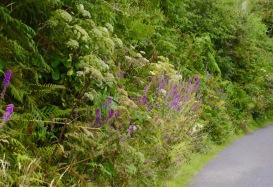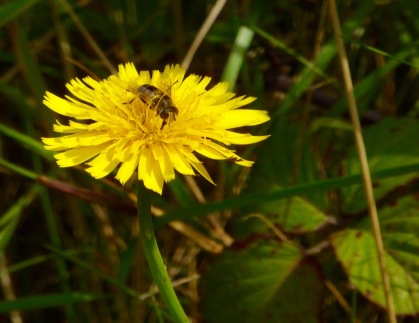 Heather blooms here in late summer and through the autumn – not, as in the song lyrics, when “the summer time is comin’”. It washes the hillsides with a rich pink-purple that has to be seen to be truly appreciated. The gorse has a late bloom too and the combination of the purple heather and the brilliant yellow gorse is one of my favourite things at this time of year.
Heather blooms here in late summer and through the autumn – not, as in the song lyrics, when “the summer time is comin’”. It washes the hillsides with a rich pink-purple that has to be seen to be truly appreciated. The gorse has a late bloom too and the combination of the purple heather and the brilliant yellow gorse is one of my favourite things at this time of year.
We’ve been walking the little roads around us in West Cork again, and observing the new cycle of hedgerow flowers since I last reported on them in June.
Inspired by my Ellen Hutchins experience, I set out to identify some of the most conspicuous of them, aided by my Zoë Devlin book and my friend Amanda.
Most striking, of course, is that combination of drooping fuchsia and the gaily waving montbretia (or crocosmia) underneath. Although technically both are introduced species, together these two flowers define the south west of Ireland – it’s what we see in our mind’s eye when we think of West Cork.
Now the berries are ripening and it’s impossible to walk without keeping an eye out for particularly juicy blackberries.
Although, because we’ve had a cold and wet summer, lots of the brambles are only flowering now.
Sloes too, with their glossy blueblack skins are there for the picking. Sloes are the fruit of the blackthorn, often used for making sloe gin. They are actually a type of small plum and are considered edible after the frost. (Note to self – must try one!) Blackthorn hedges are common around here as they make an impenetrable, thorny cattle-proof fence. The wood was prized in the past for making walking sticks that could also be used as clubs, sometimes called shillelaghs. Traditionally, they were cured and acquired their glossy black colour by sticking them up the chimney.
Whitethorn, or hawthorn, hedges and their red berries, or haws, are equally ubiquitous in September. We love to see our garden birds descend on the whitethorn trees in the winter, knowing that the haws provide an important source of nutrition for them.
The wild roses, white and pink, still sport a few blooms but now mostly the colour comes from the rose hips, the more domesticated ones huge and glossy and the wilder ones smaller and half-hidden among the brambles. I’ve never made rose hip jelly, which is apparently packed with Vitamin C, but I did pick up a delicious rose hip and apple jam at one of our local markets recently, and I’ve been enjoying it on my morning toast.
One of the dominant flowers in the hedges and ditches now is purple loosestrife. In lower-lying marshy ground it masses in a vivid amaranthine swath.
We can admire it freely here, although when I lived in Canada I knew it as an invasive weed to be feared and eliminated. Researching this online, I came across this excellent article by the Examiner’s Dick Warner. As he explains it, once purple loosestrife established itself in North America…
In these new homes, without any natural ecological controls, it became invasive and threatened to choke up important watercourses. The main reason this doesn’t happen in Ireland is that purple loosestrife is kept in check by a number of specialised and very efficient insect predators.
There are known to be two species of beetle, two species of weevil and one species of moth that feed virtually exclusively on purple loosestrife and control its spread. In America, the first thing they tried when it started to become a problem was to control it mechanically, by cutting and removing it. When this didn’t work they tried chemical control, spraying it with herbicides. Not only was this equally unsuccessful, it had some very undesirable environmental repercussions. Using toxic substances in or around water is always problematic.
Then the scientists looked to Europe. They decided the moth with caterpillars that ate purple loosestrife was itself a potential pest, so they left it alone. But they imported the beetles and the weevils and they did an excellent job. It’s one of the classic success stories of biological pest control.
The grasses, brackens, hogweed and ragwort have colonised the hedges and jostle for space in the corners of the fields.
Thistles have now mostly lost their purple heads but are no less spectacular for that.
In fact seed heads of all kinds provide an ethereal fringe to many of the hedges, while the breeze in the grasses supplies the music.
Knapweed (top) and ragwort seed heads
A few of the smaller flowers can be easily missed.
Common dog-violet (left) and tormentil (right)
And even some of the larger ones are easy to ignore because they’re so common. But look closely…
Meadowsweet (upper) and Scabious (lower)
And here’s a handsome one – Hemp Agrimony, sometimes known as Holy Rope or St John’s Herb. Apparently you’re supposed to boil the root in ale as a purgative or to cure dropsy. Now you know.
Finally, and because many of you cherish the memory of curling up with Baroness Orczy as teenagers, here’s a Scarlet Pimpernel.
All the photographs in this collection, with one exception, were taken on one day, September 8. There’s more, so much more, to see and hear at this time of year along the boreens of West Cork, but I’ll leave it at that for now, except to show you whom I was sharing all this with on my walk.
Clockwise from top: blackberry, dog rose, rose hip, hawkbit, herb robert and a species of willowherb. All with visitors.
Oh and one more thing… there are many versions of the song Wild Mountain Thyme on YouTube, but this one struck me because of the lyrics. Subtle changes make the song both more romantic and more accurate. See what you think.



































Finola,
I went blackberry picking last Sunday along one of my favourite boreens near Nad in North Cork, which is usually loaded with blackberries and was surprised to find hardly any this year – presumably it was due to the cold wet summer this year? Interestingly at a lower altitude in an overgrown ghost estate in the Blackwater Valley on the way home, I found an abundance of fruit!
LikeLike
It’s definitely not the best year for them. Unlike you, I haven’t found the mother load yet!
LikeLike
All so lovely. Thanks for sharing. I love your postings.Mary Jeangranddaughter of Johanna of Dunlough
From: Roaringwater Journal To: mjmulherin@yahoo.com Sent: Sunday, September 13, 2015 2:03 PM Subject: [New post] All Around the Bloomin’ Heather #yiv7953731748 a:hover {color:red;}#yiv7953731748 a {text-decoration:none;color:#0088cc;}#yiv7953731748 a.yiv7953731748primaryactionlink:link, #yiv7953731748 a.yiv7953731748primaryactionlink:visited {background-color:#2585B2;color:#fff;}#yiv7953731748 a.yiv7953731748primaryactionlink:hover, #yiv7953731748 a.yiv7953731748primaryactionlink:active {background-color:#11729E;color:#fff;}#yiv7953731748 WordPress.com | Finola posted: “Heather blooms here in late summer and through the autumn – not, as in the song lyrics, when “the summer time is comin’”. It washes the hillsides with a rich pink-purple that has to be seen to be truly appreciated. The gorse has a late bloom too and the c” | |
LikeLike
Hi Mary Jean. Thanks! I’d love to know more about Joanna of Dunlough!
LikeLike
Lovely Finola, I share your fascination with the wild flowers and shrubs that surround us. I like the Rod Stewart version of ‘Will ye go Lassie,go’ but not keen on the illustrations- that Lassie would freeze to death up in the Scottish hills!
LikeLiked by 1 person
Lassies don’t seem to mind freezing, if the crowd outside the pubs on a Saturday night is any indication.
LikeLike
Gorgeous post! I did one very similar to this myself, back in June I think it was. I just couldnt believe how bountiful our hedgerows and verges are. And you miss it completely by car. Might be a good time to revisit it, now the berries are out.
LikeLike
Hi Ali. Just read your post. Great minds think alike! Love all your background detail
LikeLiked by 1 person
Thank you! Well, my photography skills are not great, but I’m learning. Your images are so beautiful! And also, I don’t know what all the plants I see are, and probably identified them incorrectly. But the diversity and abundance of the flora just stunned me! How beautiful the world is, right underneath our very noses, and most of the time, we don’t even notice! Thank you for reading my post and commenting, appreciate it.
LikeLike
Writing a blog has been great for encouraging me to really LOOK. Yours is full of delights.
LikeLiked by 1 person
Thank you! You are very kind!
LikeLike
Lovely photos Finola! Yes, we are indeed privileged to see this beauty on a daily basis. Thank you!
LikeLiked by 1 person
Thank you, Jack! That’s the word – privileged!
LikeLike
Enjoyed reading
From a very wet dublin
LikeLiked by 1 person
Thank you, Tadhg!
LikeLike
Fantastic photos, such colour and so many varieites when you look. All this and Rod Stewart too\!
LikeLiked by 1 person
Well, it was him or the Clancy Brothers. 😊
LikeLike
Reblogged this on West Cork History.
LikeLike
Just got your recipe – will definitely try this and report back! Thank you!!
LikeLike